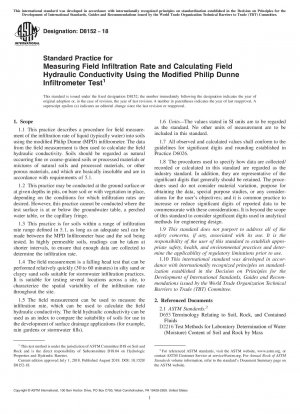ASTM D8152-18
Standard Practice for Measuring Field Infiltration Rate and Calculating Field Hydraulic Conductivity Using the Modified Philip Dunne Infiltrometer Test
- Standard No.
- ASTM D8152-18
- Release Date
- 2018
- Published By
- American Society for Testing and Materials (ASTM)
- Latest
- ASTM D8152-18
- Scope
- 1.1 This practice describes a procedure for field measurement of the infiltration rate of liquid (typically water) into soils using the modified Philip Dunne (MPD) infiltrometer. The data from the field measurement is then used to calculate the field hydraulic conductivity. Soils should be regarded as natural occurring fine or coarse-grained soils or processed materials or mixtures of natural soils and processed materials, or other porous materials, and which are basically insoluble and are in accordance with requirements of 5.1. 1.2 This practice may be conducted at the ground surface or at given depths in pits, on bare soil or with vegetation in place, depending on the conditions for which infiltration rates are desired. However, this practice cannot be conducted where the test surface is at or below the groundwater table, a perched water table, or the capillary fringe. 1.3 This practice is for soils within a range of infiltration rate range defined in 5.1, as long as an adequate seal can be made between the MPD Infiltrometer base and the soil being tested. In highly permeable soils, readings can be taken at shorter intervals, to ensure that enough data are collected to determine the infiltration rate. 1.4 The field measurement is a falling head test that can be performed relatively quickly (30 to 60 minutes) in silty sand or clayey sand soils suitable for stormwater infiltration practices. It is suitable for testing several locations across a site, to characterize the spatial variability of the infiltration rate throughout the site. 1.5 The field measurement can be used to measure the infiltration rate, which can be used to calculate the field hydraulic conductivity. The field hydraulic conductivity can be used as an index to compare the suitability of soils for use in the development of surface drainage applications (for example, rain gardens or stormwater fills). 1.6 Units—The values stated in SI units are to be regarded as the standard. No other units of measurement are to be included in this standard. 1.7 All observed and calculated values shall conform to the guidelines for significant digits and rounding established in Practice D6026. 1.8 The procedures used to specify how data are collected/ recorded or calculated in this standard are regarded as the industry standard. In addition, they are representative of the significant digits that generally should be retained. The procedures used do not consider material variation, purpose for obtaining the data, special purpose studies, or any considerations for the user’s objectives; and it is common practice to increase or reduce significant digits of reported data to be commensurate with these considerations. It is beyond the scope of this standard to consider significant digits used in analytical methods for engineering design. 1.9 This standard does not purport to address all of the safety concerns, if any, associated with its use. It is the responsibility of the user of this standard to establish appropriate safety, health, and environmental practices and determine the applicability of regulatory limitations prior to use. 1.10 This international standard was developed in accordance with internationally recognized principles on standardization established in the Decision on Principles for the Development of International Standards, Guides and Recommendations issued by the World Trade Organization Technical Barriers to Trade (TBT) Committee.
ASTM D8152-18 Referenced Document
- ASTM D2216 Standard Test Method for Laboratory Determination of Water (Moisture) Content of Soil and Rock by Mass
- ASTM D2937 Standard Test Method for Field Determination of Soil Density by the Pushing Cylinder Method*, 2024-04-21 Update
- ASTM D3740 Standard Practice for Minimum Requirements for Agencies Engaged in the Testing and/or Inspection of Soil and Rock as Used in Engineering Design and Construction
- ASTM D5879 Standard Practice for Surface Site Characterization for On-Site Septic Systems
- ASTM D5921 Standard Practice for Subsurface Site Characterization of Test Pits for On-Site Septic Systems
- ASTM D6026 Standard Practice for Using Significant Digits in Geotechnical Data
- ASTM D653 Standard Terminology Relating to Soil, Rock, and Contained Fluids
- ASTM D6938 Standard Test Methods for In-Place Density and Water Content of Soil and Soil-Aggregate by Nuclear Methods (Shallow Depth)*, 2023-05-17 Update
ASTM D8152-18 history
- 2018 ASTM D8152-18 Standard Practice for Measuring Field Infiltration Rate and Calculating Field Hydraulic Conductivity Using the Modified Philip Dunne Infiltrometer Test
